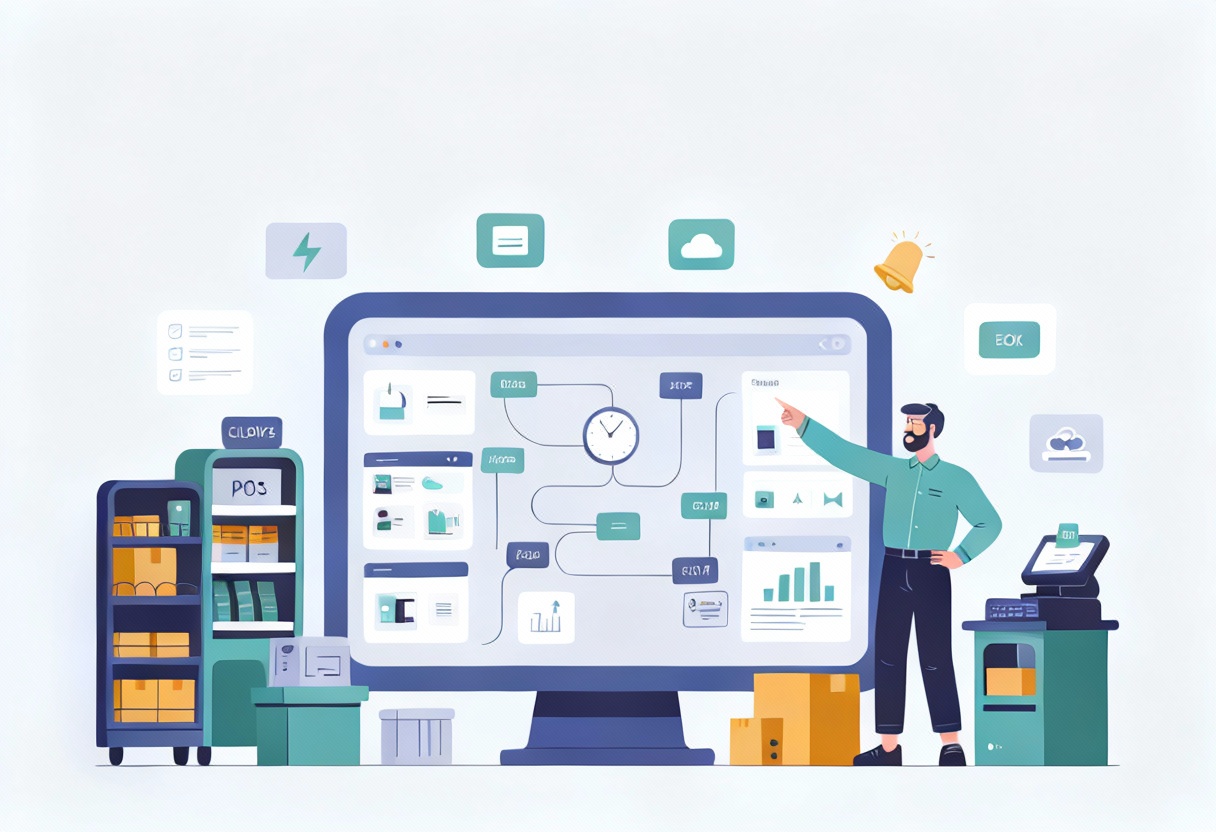Ecommerce automation has reshaped how online businesses handle operations, communication, and growth. As competition intensifies, choosing the right automation software becomes a defining factor in maintaining accuracy and agility. The right ecommerce automation software connects data, processes, and people under one framework that adapts to changing demand.
This article from ConnectPOS advises business owners on how to assess automation tools that align with real operational goals and create measurable impact.
Highlights:
- Ecommerce automation turns repetitive retail tasks into connected, data-driven workflows. The right software aligns scalability, integration, and long-term operational goals.
- Core capabilities such as inventory sync, customer segmentation, and predictive analytics drive measurable efficiency.
What Is Ecommerce Automation and Why It Matters
Ecommerce automation refers to the use of technology to handle repetitive digital commerce tasks once managed manually from updating inventory and processing orders to personalizing marketing campaigns and managing customer communication.
The ecommerce automation software connects systems across ERP, CRM, and marketing platforms, transforming isolated workflows into a synchronized operation that functions with consistency and traceability. Each automated trigger, whether an abandoned cart reminder or a restock alert, maintains momentum without requiring constant staff intervention.
The significance of automation lies in measurable outcomes. As transaction volumes rise, the margin for manual oversight tightens. Retailers adopting automated systems report faster fulfillment cycles, fewer data discrepancies, and greater customer retention through timely engagement.
The global retail automation market was valued at USD 29.02 billion in 2024 and is projected to reach approximately USD 71.91 billion by 2034, growing at a CAGR of 9.50% between 2025 and 2034. This research underscores that automation is no longer a peripheral enhancement but a strategic imperative, driving efficiency, consistency, and scalability across operations.

As data synchronization and real-time analytics become core differentiators, automated systems empower businesses to predict demand, personalize engagement, and deliver smooth omnichannel experiences that traditional workflows can no longer sustain.
How to Select the Right Ecommerce Automation Software?
Selecting ecommerce automation software requires a structured approach grounded in operational insight and technical evaluation. The right system aligns with business workflows, scales alongside growth, and safeguards data integrity. This section outlines key considerations that guide leaders toward technology choices delivering measurable business impact and sustainable performance.
Identify Your Operational Needs
A successful automation strategy begins with a precise understanding of what your business demands daily. Each ecommerce operation carries a mix of manual routines including inventory updates, order confirmations, and marketing workflows that often create hidden friction.
Mapping these activities reveals the points where automation brings measurable improvement. Teams should record where time is lost, data gets repeated, or customer touchpoints fall through.
►►► Optimal solution set for businesses: Multi store POS, Next-gen POS, Inventory Management Software (MSI), Self Service, Automation, Backorders
Once the bottlenecks are clear, define what outcomes the system must achieve. A retailer might focus on faster replenishment alerts, while a B2B distributor may prioritize order accuracy or customer segmentation. The goal is to translate operational gaps into functional requirements. This clarity prevents overbuying or selecting ecommerce automation software that looks sophisticated but solves little.
Evaluate Core Features
The foundation of any automation platform lies in its practical capabilities. Businesses should focus on the tools that directly support their processes like workflow automation, predictive analytics, campaign scheduling, and centralized reporting. Each feature should reflect how people actually work, not how software is marketed. When features align with real use cases, adoption becomes smoother and measurable outcomes follow naturally.
Ease of setup and modification matters just as much as functionality. Teams need to adjust triggers, rules, and notifications without constant developer input. A clear dashboard, transparent data flow, and logical automation builder are signs of mature design. The system should help teams move faster without changing how they think or operate.
Assess Integration and Scalability
Automation works only when it communicates across all business systems. The software must integrate with ERP, CRM, marketing, logistics, and accounting platforms already in place. When systems operate in silos, errors multiply and decisions lag. Checking for open APIs and pre-built connectors helps avoid custom coding that inflates long-term cost and maintenance.
Scalability defines how well the platform grows with transaction volume, product range, and traffic spikes. Businesses should examine case studies of companies with similar scale and complexity to understand real-world performance. An ecommerce automation software that handles small operations well but struggles during expansion can quietly restrict future growth.
Compare Vendors and Pricing
Vendor selection extends beyond technical checklists. The right partner understands retail dynamics, integration depth, and post-launch realities. Reviewing independent case studies, peer recommendations, and uptime metrics reveals how a platform performs under commercial pressure. Decision-makers should also speak directly with client references to validate long-term reliability.
Pricing models differ widely, some charge per transaction, others per user or automation volume. The total cost of ownership must include setup, onboarding, data migration, and periodic upgrades.
An attractive entry price can disguise hidden expenses or feature limitations that surface later. A careful financial model built on realistic usage projections prevents unexpected strain on budgets.
Prioritize Support and Security
Automation is only as dependable as the support that stands behind it. A responsive vendor team that understands ecommerce operations can prevent disruption during high-volume periods. The quality of technical documentation, training, and service-level agreements indicates how much value a business will gain after purchase.
Security is equally decisive. Ecommerce automation software handles sensitive information such as payment data, customer profiles, and operational reports so compliance and data governance cannot be secondary.
Businesses should confirm encryption protocols, access control policies, and certifications such as ISO 27001 or SOC 2. Trust is earned through transparency, and security maturity reflects how seriously a vendor treats partnership.
ConnectPOS: A Comprehensive Automation Solution for Your Business
ConnectPOS transforms ecommerce operations by replacing manual work with data-driven control. The ecommerce automation software unifies products, orders, customers, and marketing into one connected system, removing gaps between channels. Serving as a central hub that links POS, ERP, CRM, and marketing tools, ConnectPOS helps businesses automate processes, maintain accuracy, and grow through smart, connected decisions.
Features
- Unified Automation Hub: Connect workflows across sales, inventory, content, and customer data through robust API connections that synchronize every transaction in real time.
- No-Code Workflow Builder: Create intelligent automations through visual triggers and conditions that execute complex actions without requiring technical expertise.
- Real-Time Store and Inventory Updates: Automate stock synchronization, category management, and bulk product adjustments to maintain consistent visibility and accuracy.
- Order Reliability and Risk Control:Track fulfillment progress, issue alerts for irregularities, and strengthen trust through transparent communication.
- Integrated System Connectivity: ConnectPOS integration capabilities as a connector or middleware, linking ERP, CRM, POS, and loyalty programs for cohesive data flow and business alignment.
- Personalized Marketing Automation: Build customer loyalty through behavior-based segmentation, targeted promotions, and automated re-engagement campaigns.
- Dynamic Discount and Pricing Management: Schedule discounts or apply strategic group pricing to stimulate sales momentum while preserving margins.
- Smart Data Reporting and Custom Dashboards: Transform operational data into actionable insights through tailored reports and interactive dashboards.
- Secure Backup and Restoration:Safeguard business continuity with online data backup and instant recovery for uninterrupted operations.
- Scalable Integration Ecosystem: ConnectPOS supports an open API environment that adapts to growth, enabling businesses to expand automation capacity across departments and platforms.
FAQs: Ecommerce Automation Software
What factors should businesses review before adopting ecommerce automation software?
Businesses should examine their workflow complexity, data sources, and sales channels. A clear understanding of pain points such as delayed order processing, inconsistent data, or manual marketing triggers, helps define automation priorities and evaluate software that aligns with those needs.
How can a company measure the value of automation software?
The value becomes clear through measurable outcomes such as shorter fulfillment times, fewer stock discrepancies, and higher customer retention. Tracking KPIs before and after implementation reveals how automation impacts cost control, staff productivity, and sales performance.
Should scalability be a deciding factor?
Yes. Ecommerce growth often brings new integrations, product lines, and transaction volumes. A scalable automation platform adapts to this expansion without disrupting existing systems or requiring major reconfiguration.
Conclusion
Selecting ecommerce automation software demands a clear view of business priorities, scalability, and long-term value. The right choice transforms daily management into predictable, data-backed progress.
ConnectPOS delivers automation built around retail realities such as integrating orders, inventory, and customer engagement in a single, connected environment. To explore how ConnectPOS can strengthen your digital commerce operations, contact our team for a tailored consultation.
►►► Optimal solution set for businesses: Shopify POS, Magento POS, BigCommerce POS, WooCommerce POS, NetSuite POS, E-Commerce POS



